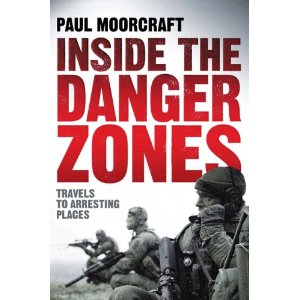Inside the Danger Zones: Paul Moorcraft on thirty years of war reporting
 Paul Moorcraft’s account of his several decades touring the world’s violent trouble-spots as a journalist and some-time government representative entertains as well as informs.
Paul Moorcraft’s account of his several decades touring the world’s violent trouble-spots as a journalist and some-time government representative entertains as well as informs.
From Rhodesia in the 1970s through to his contemplation of pioneering a niche market in blind observers for African elections in 2010, Moorcraft’s account reflects plenty of the swagger of many war correspondents but with enough self-mockery to make the account illuminating and interesting rather than a macho display. Even the clichés about drinking and womanising journalists, which he seems to have often fulfilled to the maximum, are full of his own failings.
The result is a portrait of not only the countries he visited but also the breed that makes up war correspondents, with their bravery, their bravado and their desire to get the story and the footage even at great personal risk. The motivation for such story getting may often be as much ego as public service, but in the end the public benefits from people willing to take remarkable risks with their personal safety in the name of journalism.
The dangers he was willing to put himself through were caused in part by the relentless search for footage of fighting – the bang-bang stuff in his terminology. As I’ve commented on this focus before in the context of reporting the conflict in Afghanistan:
The big problem with such footage of frontline fighting dominating is that the situation in Afghanistan is about much more than only the frontline fighting. It is a wider military, economic, social, diplomatic and political issue.
So having reporting about Afghanistan in mainstream TV dominated by the kinetic stuff provided by journalists embedded on the front line for a couple of weeks is rather like trying to cover the economy by embedding Robert Peston in a Manchester McDonald’s for a fortnight.
That may be interesting; that may be illuminating; but as a way of finding out and reporting on whether the whole UK economy is going to continue recovering or suffer a double-dip recession it would be woefully inadequate on its own.
Moorcraft also talks of this problem, acknowledging how the hunt for bang-bang can distract from telling the real story, but he says,
TV depends upon pictures. No pictures, no story. The best stories involve drama, action, and often bang-bang. That is the nature of the beast. It is hard to record trends rather than events.
A taste of the book’s tone to come is given in the foreword which says, “I have few acknowledgements, mainly because most of the people I met in this line of work did everything they could to hinder, discourage or, occasionally, shoot me.”
His account brings back into the public light many of the forgotten by-ways of history, such as how close the Russians came to winning the guerilla war in Afghanistan before the US stepped in and provided Stinger missiles to the Mujahideen, undermining the crucial Soviet air superiority, or the impact of international financial markets in putting pressure on the apartheid government in South Africa in its final days, having an impact beyond that which government-sponsored sanctions could manage.
Towards the end, the book fades a little into a collection of short anecdotes, one after another thrown at the reader, rather than the longer, more analytical accounts in the book’s earlier stages, but all through it is an entertaining and educative read.
You can buy Paul Moorcraft’s Inside the Danger Zones: Travels to Arresting Places here.
Leave a Reply